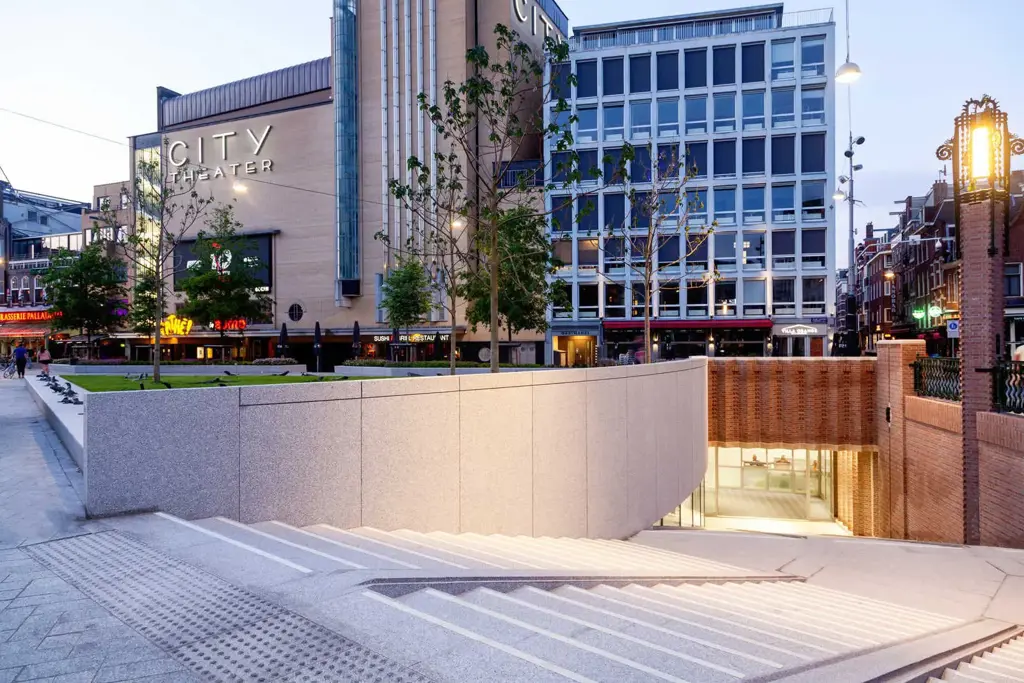Fietsenstalling Leidseplein, Amsterdam
Description
Parkeergarage voor een fiets-stad
Ongeveer veertig procent van al het verkeer in Amsterdam bestaat uit fietsers. Je moet er niet aan denken wat een chaos het zou worden als al die mensen zich zouden verplaatsen met bussen of auto’s. Het parkeren van fietsen in de binnenstad is wel een toenemend probleem. De tijd dat je je fiets op slot zette voor de deur van de winkel waar je moest zijn is voorbij. De gemeente ontwikkelt beleid om straten en pleinen vrij te houden van gestalde fietsen en parkeergelegenheden aan te bieden op gewenstere plekken. Architectenbureau ZJA verwierf samen met Ballast Nedam de opdracht van de gemeente Amsterdam om een ondergrondse fietsenstalling te bouwen onder het Kleine-Gartmansplantsoen, pal aan het Leidseplein. En maakte in samenwerking met kunstenaar Hans van Houwelingen een bijzonder ontwerp.
Opgaan in de omgeving
Het plantsoen is de locatie voor een openbaar kunstwerk dat met de komst van de fietsenstalling een nieuwe verschijningsvorm krijgt. In 1994 werd het werk Blaauw Jan van Hans van Houwelingen onthuld. In het gras, tussen de struiken en op een bakstenen verhoging stonden veertig levensechte bronzen hagedissen: varanen, leguanen en agames. Het zijn symbolen van overlevingskunst en wederopstanding en bovendien prachtige droomachtige wezens die de stad bij dag en nacht verrijken. De titel Blaauw Jan verwijst naar een herberg die in de 17e en 18e eeuw op de Kloveniersburgwal om de hoek gevestigd was, en een binnenplaats had met een heuse dierentuin waarin leeuwen, emoes, Afrikaanse en Aziatische vogels en reptielen te zien waren.
Als onderdeel van zijn omgevingskunstwerk ‘Blaauw Jan’, habitat voor 40 bronzen hagedissen, ontwierp beeldend kunstenaar Hans van Houwelingen de entree van de fietsenstalling. Een granieten kromme wand, die doet denken aan een stuwdam, en een bakstenen ‘tweede helft’ van de Amsterdamse School brug over de Lijnbaansgracht uit 1913, leiden de fietser naar binnen. Daar laat de kunstenaar de bakstenen muur zigzaggend langs de gehele noordwand doorlopen wat optimaal contrasteert met het hypermoderne design van de stalling van ZJA – doelbewust een clash in vormgeving en een clash in tijd, maar tegelijk een perfecte eenheid als resultaat van unieke samenwerking tussen kunstenaar en architect.
Ruim en licht
De fietsenstalling heeft bredere paden en een grotere hoogte (3.20 m) dan de meeste fietsstallingen, en extra aandacht is gegeven aan de toetreding van daglicht en verlichting boven de voetpaden, zodat de sfeer transparant en prettig is. Door de zichtlijnen te richten op de brede uitgang en de beheerdersruimte in de hoek te plaatsen is overzicht en veiligheid optimaal. Aan de lange wand is een geperforeerd stalen paneel aangebracht dat de akoestiek van de fietsenstalling verbetert.
De ondergrondse fietsenstalling waar 2000 fietsen kunnen worden gestald, is helder, licht en transparant, maar door de achterwand van metselwerk in warmrode baksteen verbonden met de bovengrondse wereld van de oude brug en het speelse en raadselachtige kunstwerk dat de brug en groene plein in elkaar laat overlopen. Is het geen geruststellend idee dat als je wegloopt over het plein je de veertig bronzen reptielen passeert, die waken over de fietsen onder het plantsoen?
Architect: ZJA
Klant: Gemeente Amsterdam
Opdrachtgever ZJA: Ballast Nedam
Aannemer: Ballast Nedam Park & Connect
Beeldend kunstenaar: Hans van Houwelingen
Landschapsarchitect: Ruwan Aluvihare/Gemeente Amsterdam
[English]
Parking garage for a city of bicycles
Approximately forty percent of all traffic in Amsterdam consists of cyclists. Sheer horror to imagine the chaos if all these people were moving around by car or by bus. Parking your bicycle in the inner city however is increasingly problematic. The days when you locked your bike in front of the store where you went shopping are over. The city continues to develop policies to keep streets and squares clear of parked bicycles and to offer parking facilities at more convenient locations. Together with Ballast Nedam, the architectural studio ZJA secured the commission by the city of Amsterdam to design and build an underground bicycle parking beneath the Kleine-Gartmansplantsoen, right next to the Leidseplein.
Merged into the surroundings
The green is the original location for a public work of art that will be given a new appearance with the advent of the bicycle parking. The Blaauw Jan (Blue John) by Hans van Houwelingen was revealed in 1994. On the grass, between the bushes and on the low brick walls stood forty true to life bronze lizards: monitor lizards, iguanas and agamas. Symbols of supreme survival skills and resurrection and besides that beautiful dream creatures that enrich the city by day and night. The title ‘Blaauw Jan’ refers to an inn located at the Kloveniersburgwal just around the corner during the 17th and 18th centuries that had a courtyard housing a veritable zoo where one could admire lions, emus, African and Asian birds and reptiles.
Integrated with his existing public art installation ‘Blaauw Jan’, which consists of 40 bronze lizards spread across the square, Hans van Houwelingen has now designed the entrance of the bicycle parking. Cyclists are led into the underground parking by a granite curved wall on the left, reminiscent of a dam. On the right, there is a brick structure which forms the 'second half' of the bridge over the Lijnbaansgracht from 1913, fashioned in the Amsterdam School style. There, the artist has the brick wall zigzagging along the entire north wall, maximizing the contrast with the hypermodern design of the ZJA bicycle parking. A deliberate clash in design and a confrontation of eras, yet as a spatial experience it forms a natural unity due to the unique collaboration between artist and architect.
Spacious and bright
The bicycle parking has wider footpaths and a higher ceiling (3.20 m) than most facilities for storing bicycles, and extra attention is given to the entry of daylight and the lighting of the footpaths, in order to produce a transparent and pleasant atmosphere. By directing the sight lines towards the wide exit and positioning the keeper’s office in the corner a clear overview and a feeling of safety is optimized. Along the longest wall at the back a perforated steel panel improves the acoustics of the bicycle parking.
The new underground bicycle parking for 2000 bikes is clear, light and transparent by design, with the back wall in warm red masonry connecting it to the world above ground with the old brick bridge and the playful and mysterious artwork that embraces the bridge and the green square. Is it not reassuring to walk away from the square, knowing that forty bronze reptiles watch over the bicycles deep under the green?
Architect: ZJA
Principal: The municipality of Amsterdam
Client ZJA: Ballast Nedam
Contractor: Ballast Nedam Park & Connect
Visual artist: Hans van Houwelingen
Landscape architect: Ruwan Aluvihare/The municipality of Amsterdam
Expertise: Architecture Features or Specials: Artwork, Materials, Historical connection Awards: Winner: Architecture MasterPrize 2021, Nomination: WAN Transport Award 2021

Werk ook slimmer met Galleo
Galleo brengt projectdata, kennis en AI samen in één veilige, schaalbare oplossing. Toonaangevende bedrijven zoals ABT, Movares, CLAFIS en Witteveen+Bos kiezen al voor Galleo. Sluit je aan.
Neem contact op met Barbara of Kars
We werken zelf in de gebouwde omgeving en adviseren je graag, met praktijkervaring en vakkennis, over wat het beste werkt voor jouw organisatie.
Neem contact op